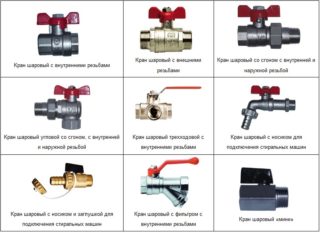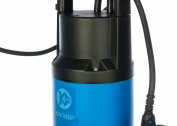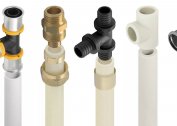The device of the water supply system is not complete without a stopcock. It completely blocks the water supply to the system or one of its points or limits the pressure. In private construction (for an apartment or a cottage) mainly use water taps and valves for plastic pipes. The metal system also has its own components.
Types of water valves and their device
 A water valve is a special stop valve that is installed at the inlet of the system to one or more plumbing points. Using a faucet, you can restrict the flow of water to only one device (toilet, sink, washing machine) or throughout the riser at once. It all depends on which section of the water supply the fittings are installed.
A water valve is a special stop valve that is installed at the inlet of the system to one or more plumbing points. Using a faucet, you can restrict the flow of water to only one device (toilet, sink, washing machine) or throughout the riser at once. It all depends on which section of the water supply the fittings are installed.
Locking mechanisms are classified into several categories depending on the principle of operation, design, material of manufacture, throughput and method of attachment to the pipe.
According to the principle of operation, two types of valves are distinguished: ball and valve. The first works due to a special locking mechanism in the form of a ball inside, which has a special hole. At the moment of rotation of the lever / tap, the sphere rotates in such a way that the gap is perpendicular to the flow of water in the pipe. Her feed stops. This is clearly visible on all assembly drawings for valves. The positive aspects of the ball valve are the complete tightness of the blocked pipe, the simplicity of the mechanism and the long service life. This type of water valve cannot be repaired. The most durable of this class is considered the mechanism of brass "Bison" on the pipe ¾ inch.
Valve assembly consists of a gasket that is mounted on a stem. At the time of rotation of the valve, it partially or completely blocks the flow of water, depending on the position of the stopcock. Important positive aspects of the valve device are its maintainability and the ability to control the water pressure in the system. The disadvantages include the quick wear of the gasket and the need to make several turns with the flywheel until the water is completely blocked.
If there is a need to completely shut off water, it is better to put a ball valve. If the pressure is subject to adjustment, the valve valve is the right solution.
By design, valves are divided into three types:
- Direct-flow. Crane with a small hydraulic resistance, which is installed on a straight section of the system.
- Passing through. Designed to block the flow of water in a specific direction.
- Corner Used at the corner of the pipe. In this case, the water flow is perpendicular to the incoming direction.
According to the material of manufacture, cranes are:
- Steel. They are used more often for cold water, because scum settles on it from hot water. Old steel faucets were made of steel.
- Brass. Have a small weight and dimensions. Durable and suitable for installation on cold and hot water.
- Bronze The most expensive version of the locking mechanism with excellent performance.
- Plastic Unpretentious, durable, affordable devices.
- Flanged. Mounted using special fasteners at the edges of fittings and pipes. Connect by bolts. Such stopcocks are placed only on a metal water supply.
- Threaded. Mounted with locknuts for fixing and threading. Such a crane is selected according to its diameter, pitch and type of thread (internal / external). The threaded valve can be placed on plastic and metal pipes. In the case of plastic, special adapters are used.
- Welded.They are installed only by welding.
Only threaded and flanged valves can be removed and put back again. Weld-in cannot be reinstalled.
Throughput mechanisms are:
- Full bore. They allow almost 100% of the flow of water.
- Standard. They work with 70-80% of the fluid pressure in the system.
- Incomplete passageways. Only 40% to 50% of the flow is passed.
There are special three-way taps that allow you to connect a manometer and monitor the operation of the plumbing system.
The main criteria for choosing a stopcock
Choosing a valve at a specialized point of sale, the master pays attention to its parameters such as:
- Type of mechanism (ball, valve).
- The material of manufacture. For metal systems, brass or bronze valves are used. For polymer - plastic.
- Way of fastening.
- Throughput.
When choosing a crane according to the type of fastening, you need to consider whether the valve will be mounted once and for a long time, or in the future it will be dismantled and reinstalled.
Valve mounting methods
 Depending on the mounting method, the installation of stopcocks is carried out according to various schemes. The threaded locking mechanism is mounted in the following order:
Depending on the mounting method, the installation of stopcocks is carried out according to various schemes. The threaded locking mechanism is mounted in the following order:
- The pipe is prepared for the installation of fittings. At both ends, thread if necessary. To do this, use the required diameter of the die. It is rotated through the pipe until a thread is formed. For greater convenience, you can use a die holder.
- Lock nuts are put on both ends of the prepared pipes. They will fix the valve in the future. When installing all threaded connections, it is advisable to use FUM tape or other sealant.
- Screw on the tap and tighten it on both sides with locknuts.
Threaded mechanisms are mounted on pipelines with a cross section from 10 to 60 mm. The operating pressure in this case can vary within tens of atmospheres (select a special high-pressure valve). The type of housing can be either angular or direct-flow.
Installation of a flanged valve is performed according to the following scheme:
- Flanges are welded onto the pipes, which are then combined with the washer of the mounted crane.
- Between the washers, a sealing gasket is mandatory.
- Fixing bolts are inserted into the technical holes of the washer. They are simultaneously tightened at the time of installation of the valve. You need to do three to four turns on each fixture. No longer needed, otherwise there is a risk of breaking the thread or damaging the pipe.
Flanged valves are placed on pipelines with a cross section of 10 to 160 mm. All flanges must comply with GOST 12820-80, as indicated on the valve body. It is permissible to install both angular and direct-flow cranes of this type.
Operation and maintenance
That the crane worked without failures, it is recommended to handle it correctly:
- do not jerk sharply at the time of overlapping water;
- Do not press over against the stop;
- the ball mechanism must be left in only one of the positions (open / closed), otherwise it quickly fails;
- periodically lubricate metal valves of the old model.
If valve fittings are used, it is advisable to install a special filter at the system inlet. This will protect the gasket (valve) from excessive wear.




